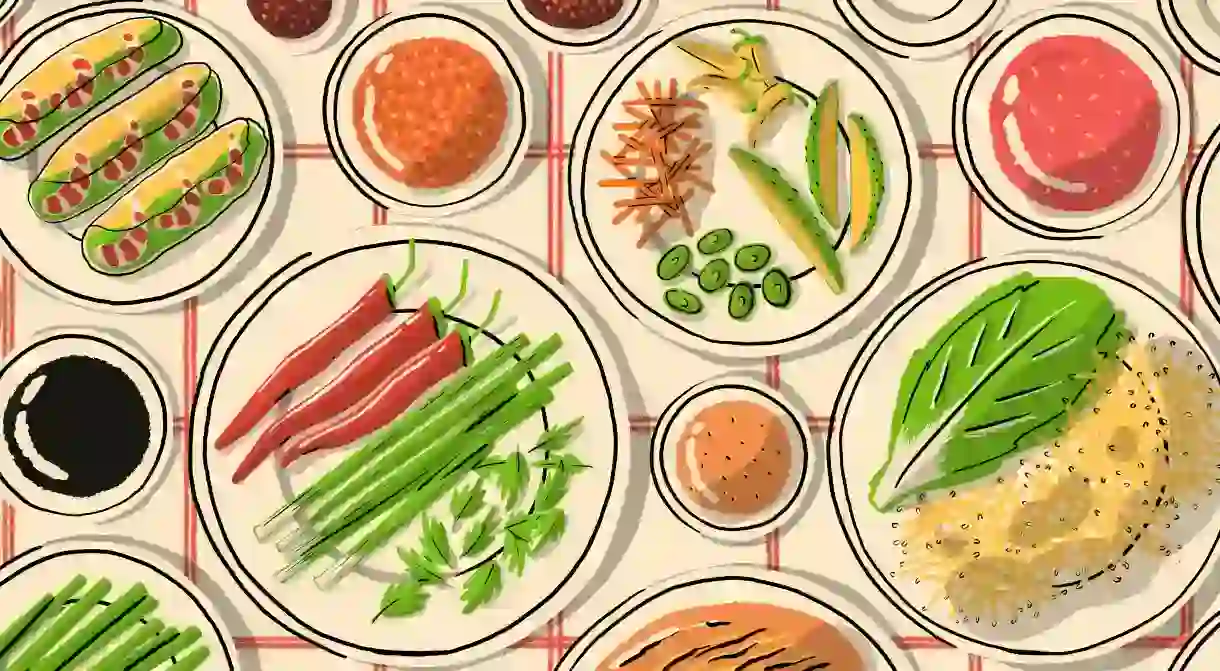A Guide to Vietnamese Condiments

If you come across a dining table in Vietnam without condiments, then it has not been fully set. To perfect your palate, here is an essential guide to the country’s sides and sauces.
Vietnamese condiments are grouped into four different categories: dipping sauces, pickled vegetables, flavourings and garnishes. From fish sauce to the basket of greens that grace every table, these are more than mere accoutrements – they define the Vietnamese eating experience.
Vietnamese dipping sauces
Fish sauce is indispensable in Vietnamese cuisine, but also throughout other countries in Southeast Asia such as Thailand, Laos and Cambodia. To make it, anchovies are salted, pressed and left inside a wooden barrel to ferment for months under the sun. The dark, amber-hued juices are then extracted, bottled and sold.
Akin to what olive oil is to Italian culture and soy sauce is to China and Japan, fish sauce (or nước mấm), is used in everyday cooking in Vietnam, often as a replacement for salt. It is mixed in stir-fries, added to stews and used to caramelise vegetables and meat for clay-pot dishes.
You will often find a small bowl of fish sauce on your table in Vietnam. You can choose to add it in as a seasoning, or use as a dipping sauce. Sometimes it is diluted with other ingredients, such as lime, chilli or sugar.
Nước chấm
Nước chấm is fish sauce diluted with water, lime juice, sugar, garlic and pieces of chilli. This sauce accompanies most dishes, either with the ingredients already mixed together, or served separately for you to combine as you please. Vietnamese households often make batches large enough to last a few days.

Oyster sauce
This sweet and savoury sauce is made from the essence of boiled oysters, mixed with sugar and water then thickened with cornstarch. It works best when incorporated into sautés or stir-fries, and is very effective at toning down the bitterness of leafy greens. A popular Vietnamese dish that incorporates oyster sauce is bò lúc lắc, or “shaking beef” in English.
Shrimp sauce
A contender for one of the smelliest foodstuffs in the world, shrimp sauce is a divisive yet extremely popular condiment in Vietnam. It is made using fermented shrimp and salt, resulting in a purple paste. Shrimp sauce is commonly used to marinate and sauté dishes, the most famous being the noodle soup bún riêu. This southern Vietnamese dish is made with tomato broth and freshwater crab. It is also used as a dipping sauce, meaning you can get up close and personal with it yourself.
Others
Besides the aforementioned, there are a wealth of other dipping sauces in Vietnam, commonly served as accompaniments to specific dishes. Nước lèo, is a peanut sauce, served with nem nướng: a dish of grilled pork meatballs, or gỏi cuốn: fresh Vietnamese spring rolls. Mắm nêm, a pineapple and anchovy dip, is served alongside certain beef dishes such as bò nhúng dấm (beef fondue).

Pickled vegetables
Do chua (translated literally as “sour things”), are pickled and preserved vegetables that are eaten on an almost daily basis. Order any dish in Vietnam and you will find a plate of deliciously sour pickled cucumbers, carrots, daikon and cabbage. If not served on a plate, they sometimes come in a jar.
To initiate the pickling process, locals use a mixture of white rice vinegar, salt and sugar. The vegetables are then preserved inside a concoction of salted water. Given the saltiness and pepperiness of many Vietnamese dishes, the tangy, slightly sweet taste of pickled veggies go extremely well. They are particularly great with barbecued meats and seafood.
Flavourings
Flavourings are generally not served at the table, but are instead used during the preparation of the dish. Sate (or Satay), a mixture of peanuts, garlic and chilli paste, is commonly added to stir-fries. Lemongrass is most often used for braising meats, adding citrusy notes to the dish. Because of the rich flavour they incorporate, these dishes are best served with a helping of fresh, plain white rice.

Garnishes
Garnishes include the likes of fried shallots, chillies and aromatic greens. These are often sprinkled over fried rice, soups and grilled meats or seafood as an addition after the cooking process.
You will often find fried shallots sprinkled over your bowl of phở, adding a crunchy texture and sweeter taste. Chillies are sliced and served in a small plate or mixed into the bowl of fish sauce, for an extra kick. Aromatic greens come in a little basket, which not only add texture and flavour, but also freshness to cooked dishes.
The basket includes traditional herbs such as basil and coriander, alongside vegetables such as green onions, lettuce leaves and bean sprouts. On a lucky day, you may even find sliced cucumber, unripe starfruit and shredded carrot. A combination of these chopped greens is served with popular dishes such as chả giò (fried spring rolls), nem nướng and even rice noodle soups. Throw a handful into your bowl and their fragrant juices will seep into the steamy broth – their stalks add a slight crunch to offset the chewiness of the noodle and meat.
If you’re eating any kind of Vietnamese soup, whether it’s mì quảng or bún bò Huế, you’ll find yourself starting with a squeeze of lime before you dig in. Fun fact: lime wedges are also used to clean chopsticks.













